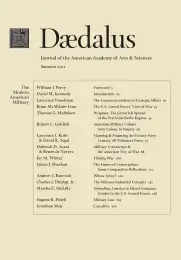The U.S. Armed Forces’ View of War
Many military analysts now argue that the challenges of Iraq and Afghanistan have prompted a paradigm shift within the U.S. armed forces. They believe that techno-centric formulaic concepts of warfare, such as effects-based operations, have been replaced by more complex, human-centered approaches, such as those laid out in the 2007 Counterinsurgency Manual. This essay details the evolution of U.S. military thought about warfare. It discusses how lessons from the past shaped current policy, the impact of a technologically inspired Revolution in Military Affairs (RMA), and the subsequent conviction that properly equipped U.S. armed forces could rapidly and decisively defeat any and all opponents. The inability of U.S. forces to achieve national objectives in either Iraq or Afghanistan despite their success on the battlefield has caused war intellectuals to seek new lessons from history, question the existence of an RMA, and formulate a new vision of war that stresses uncertainty, adaptation, and innovation.
Despite the continual issuance of buzzwords emphasizing service unity and harmony–such as “jointness,” “An Army of One,” or “The Few, the Proud”–the armed forces’ internal divisions have been vividly displayed during the last decade. A number of important books detail the disagreements between civilian and military leaders and the long struggle to implement the “surge” and the counterinsurgency (COIN) strategy.1 The wars in Iraq and Afghanistan have generated a radical transformation in military thought: that is, a paradigm shift from idealized, techno-centric, scientific formulas–such as “network-centric warfare” (NCW) or “effects-based operations” (EBO)–to more complex, ambiguous, and human-centered visions of war, which were encapsulated in 2007 by The U.S. Army/Marine Corps Counterinsurgency Field Manual.2 This intellectual renaissance has led, according to some, to military victory in Iraq and a path to eventual success in Afghanistan. This interpretation is attractive because it implies that the U.S. armed forces are adaptive, learning organizations that will develop new concepts to replace failed ones. But it begs a number of central ques- . . .
